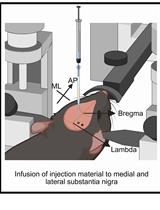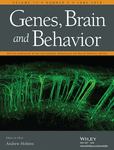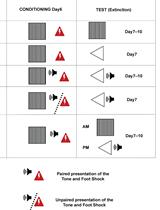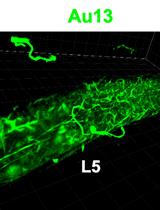- EN - English
- CN - 中文
A Single Test to Study Social Behavior and Repetitive Self-grooming in Mice
研究小鼠社交行为和重复自我修饰的单一试验
(*contributed equally to this work) 发布: 2020年01月20日第10卷第2期 DOI: 10.21769/BioProtoc.3499 浏览次数: 5670
评审: Edgar Soria-GomezShauna ParkesAnonymous reviewer(s)

相关实验方案

基于 rAAV-α-Syn 与 α-Syn 预成纤维共同构建的帕金森病一体化小鼠模型
Santhosh Kumar Subramanya [...] Poonam Thakur
2025年12月05日 1387 阅读
Abstract
The ability to recognize and interact with members of the same species is essential for social communication. Investigating the neural substrates of social interest and recognition may offer insights into the behavioral differences present in disorders affecting social behavior. Assays used to study social interest in rodents include the 3-chamber test, a partition test, and a social interaction test. Here, we present a single protocol that can be used to quantify the level of social interest displayed by mice, the ability to distinguish between different individual mice (social recognition), and the level of repetitive self-grooming displayed. In the first part of the protocol, a social habituation/dishabituation test, the time spent by a test mouse sniffing a stimulus mouse is quantified over 9 trials. In the first 8 interactions, the same stimulus mouse is used repeatedly; on the ninth trial, a novel stimulus mouse is presented. Intact social recognition is indicated by a progressive decrease in the investigation time over trials 1-8, and an increase in trial 9. The interval between each social trial is used to quantify self-grooming, a stereotyped repetitive behavior in mice. We also present a method for randomized, blinded analysis of these behaviors to increase rigor and reproducibility of results. Therefore, this single behavioral test enables ready assessment of phenotypes of both social and repetitive behaviors in an integrated manner in the same animals. This feature can be advantageous in understanding interactions between these behaviors and phenotypes in mouse models with genetic variants associated with autism and other neurodevelopmental or neuropsychiatric disorders, which are often characterized by these behavioral differences.
Keywords: Behavior (行为)Background
Verbal and nonverbal communications enhance an organism’s ability to establish and maintain a social hierarchy, and thus survive and reproduce. These forms of communication rely on the motivation to interact with fellow conspecifics and the ability to recognize and distinguish between different individuals. In humans, disorders that are commonly characterized by altered social behavior include depression, anxiety, and autism (Saunders and Roy, 1999; White et al., 2009). Although there is a general understanding of symptoms, the etiologies of these disorders, particularly the underlying mechanisms of social impairments and differences, remain unclear (Goldstein and Rosselli, 2003).
Mice offer advantageous models for studying the neurobiology of behavior through similarities to certain aspects of human behavior and physiology (Austin et al., 2004; Cryan and Holmes, 2005). Although a mouse model will not perfectly replicate human disease, overall symptoms can apply when investigating theories regarding genetic or environmental modulation (Crawley, 2007). For example, much of the current preclinical autism research revolves around the diagnostic criteria of abnormal social interaction, impaired social communication and interaction, and repetitive behaviors (Silverman et al., 2010).
A social habituation/dishabituation test enables measurement of two components of rodent social behavior: 1) the interest in a familiar social stimulus shown repeatedly over a short period of time; and 2) the ability to recognize a new social stimulus (Tejada and Rissman, 2012; Ujjainwala et al., 2018). In this paradigm, the mouse used to provide a social stimulus is placed under a wire cup to confine it to a fixed location and to physically separate it from the mouse whose behavior is being examined (“test mouse”). Interest is measured by the amount of time the test mouse spends exploring the stimulus mouse under the wire cup, typically quantified through sniffing. This paradigm can be used to investigate biological and environmental influences on social interest and/or social recognition. For example, our group recently reported that mice genetically deficient for the diazepam binding inhibitor (DBI) protein show a significant reduction in social interest compared to wild-type littermates, with no deficit in social recognition (Ujjainwala et al., 2018). Furthermore, rodents often show sex differences in social interest levels (Tejada and Rissman, 2012; Karlsson et al., 2015), and sex steroid hormones, such as testosterone and estradiol, affect social exploratory behavior. Variations of this protocol have also been used to examine the loss of the oxytocin gene as well as lesions to the CA2 region of the hippocampus and their effect on social recognition (Ferguson et al., 2000; Stevenson and Caldwell, 2014). In addition, this test could be applied to further evaluate the impacts of other environmental and behavioral factors, such as social isolation or gestational exposure to bisphenol A (Wolstenholme et al., 2012; Lander et al., 2017).
Restricted repetitive behaviors are most often associated with autism in humans, but these behaviors are also present in other disorders such as Rett, Fragile X, and Prader-Willi syndromes (Crawley, 2007; McFarlane et al., 2008; Lewis and Kim, 2009). In mice, this phenotype can present in numerous forms, including repetitive grooming, circling, jumping, or other stereotypical movements (Crawley, 2007). Given the overlap between impaired social interaction and repetitive behaviors in these and other neuropsychiatric and neurodevelopmental disorders, a single protocol that enables ready and integrated assessment of multiple phenotypes is advantageous.
Another paradigm commonly used to study social interest and recognition in mice is the 3-chamber test. This test requires a specialized apparatus containing multiple chambers separated by removable doors. This configuration is of higher novelty to a mouse than an environment that mirrors the home cage, potentially inducing higher levels of general exploratory behavior rather than social interaction specifically (Yang et al., 2011). By contrast, the test described in this protocol can be performed in a standard mouse cage used for daily housing in many laboratories. The other materials required can be obtained readily at a low cost.
Blinded analyses significantly enhance experimental rigor, especially regarding manual scoring of behavior, where pre-conceptions may lead to biased evaluation. For any given study, requiring separate researchers to either conduct experiments or perform analyses is not always feasible and can lead to differences in interpretation. Here, we provide a method to randomly code, name, and sort files using Excel. This method allows for one person to conduct the behavioral test and then score the videos in a blinded fashion. This process could be used to anonymize other file types for blinded analysis as well.
Materials and Reagents
- Chrome Round Pencil Holder (Spectrum Diversified, catalog number: 31570, diameter of 10.2 cm, distance between bars of 0.64 cm, initial height of 10.8 cm)
- 400 ml plastic beaker
- Post-pubertal male or female test mice of any strain
- 2 stimulus mice (e.g., ovariectomized adult female mice)
Note: For this procedure, at least two stimulus mice are needed. Ensure both stimulus mice are of the same sex and age, and that both have had no prior contact with any of the test mice (i.e., not littermates). Stimulus mice can be either males or females as they are physically separated during the test with the cup. Commonly, ovariectomized females are used to provide neutral stimuli to quantify social interest without provoking aggressive or sexual responses. Consult with local animal care committee guidelines regarding ovariectomy surgeries if needed. - Ethyl Alcohol 70%
- Deionized (DI) water
Equipment
- MiliporeSigma Synergy Ultrapure Water Purification System (MiliporeSigma, model: SYNSOHFUS)
- Windows PC computer
- Video Camera (Logitech Webcam C930e, 90° field of view, 1920 x 1080 pixels)
Note: Any camera with similar specifications that can visualize that entire cage can be used for this protocol. - Testing chamber (bottom and filter top of standard mouse cage can be used with the dimensions of 29.3 cm x 17.1 cm x 12.7 cm for the base, and a total height of 20.3 cm with the lid placed on top)
- Corn Cob Bedding (use the same type of bedding as in the home cage)
Software
- iSpy (freeware open-source video surveillance platform available at www.ispyconnect.com)
- Microsoft Excel
- Statistics software, such as SAS
Procedure
文章信息
版权信息
© 2020 The Authors; exclusive licensee Bio-protocol LLC.
如何引用
Lawande, N. V., Ujjainwala, A. L. and Christian, C. A. (2020). A Single Test to Study Social Behavior and Repetitive Self-grooming in Mice. Bio-protocol 10(2): e3499. DOI: 10.21769/BioProtoc.3499.
分类
神经科学 > 神经系统疾病 > 动物模型
您对这篇实验方法有问题吗?
在此处发布您的问题,我们将邀请本文作者来回答。同时,我们会将您的问题发布到Bio-protocol Exchange,以便寻求社区成员的帮助。
Share
Bluesky
X
Copy link











